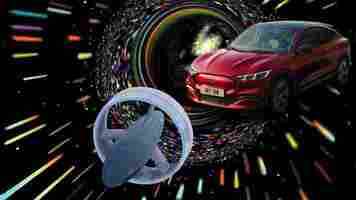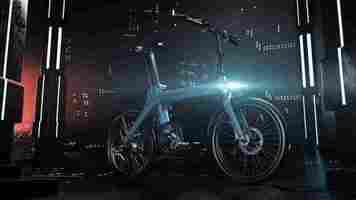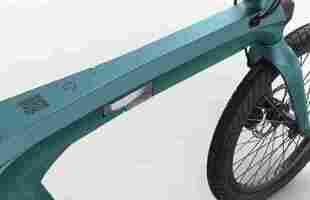Why Ford thinks human-centric design is the future
Connectivity, automation, electrification, and AI — these profound waves of change are all converging upon mobility right now. So , it’s only reasonable to wonder how legacy automakers will be able to transform as well, in order to meet the new needs of travelers.

Speaking at TNW Conference this year, Usha Raghavachari, In novation Lab Director at D-Ford, described how her team can bring a 118-year old brand into the future.
D-Ford is a design startup within Motor Company, whose mission is to help the company learn and adopt new tools to create “what’s next.”
As Raghavachari explained, D-Ford is focusing on a human-centered design approach, which aims to “drive human progress through empathy, creativity, and design.”
This means that the consumer is at the center of the circular process the startup is implementing: l earn , imagine , and design .
To make this happen, ethnographic research is conducted all around the world to identify both the logistical and the emotional needs of consumers.
Based on this data, D-Ford enters the imagine phase and tries to envision the products, services, and ideas that would address those needs.
Consumers are also encouraged to be present within the design process by getting involved in workshops and providing insights and impressions.
That way, human-centered insights and experiences can help explore how we will live and travel in years to come, and in turn, how the mobility market will evolve.
In fact, according to Raghavachari, placing the consumer in the center significantly “de-risks” the investment in future products.
She also believes that her team can transform Ford from an industrial company to an ecosystem, offering not only hardware solutions, but also software services and broader experiences.
The Fiido X is a premium upgrade to one of my favorite folding ebikes
The Fiido D11 is one of my favorite folding ebikes I’ve tested, offering sensible range and performance with a unique, attractive design. But at its entry-level $999 price point, what the bike was missing was some polish: the welds looked a little sloppy, the cables were a bit messy, and the pedaling offered basic cadence-based assistance as opposed to a fancier torque sensor .

Enter the Fiido X. Launching on Indiegogo today, the bike offers a refreshed, cleaner design than the D11 that tidies up most of my biggest pain points with the original. It also includes a torque sensor, which has the potential to make for a dramatically smoother pedaling experience, as well as improving range somewhat. It’s currently going for an introductory price of $1,099 for the model most people will want, or $899 for a lighter model with reduced range.
First, a disclaimer about Indiegogo products. With very rare exceptions, we don’t cover crowdfunding campaigns unless we’ve used a working prototype, or we’ve interacted with the company’s products previously. We have not yet used the Fiido X, but Fiido did deliver on the D11 in a relatively timely fashion despite the pandemic.
Credit: Fiido
Moreover, you’re not funding the R&D for a product here; the Fiido X is actually already in production, and the company plans to begin shipping bikes to backers in September. You should always take crowdfunding campaigns with some caution and expectation of delays, but the Fiido X has more going for it in terms of timely delivery than most products I’ve seen.
Like the Fiido D11 before it, the Fiido X is more of a ‘get around town’ bike than a speed demon. The bike comes in 350W (US) and 250W (everywhere else) models, using rear hub motors which are limited to 25 km/h (15.5 mph) and 32 km/h (19.2 mph) speeds, respectively.
The motors are rated at 40 Nm of torque, which should be enough to get most riders up most hills in conjunction with the 7 gears, but you’ll have to use some of your own legpower for the steepest ones. Still, the fact that the bike has a torque sensor is a big boon to hill climbing ability. On cadence-type bikes, it can be a struggle to start moving up a hill from a dead stop, but a decent torque sensor should kick in rapidly and provide a large amount of assist, as it can detect how hard you’re actually pedaling, not just your speed.
The Fiido X also comes with a design that, at least from the images, looks a lot sleeker than the already pretty slick D11.
The bike is using a molded magnesium alloy frame which leads to a cleaner design, and the folding mechanism is now neatly tucked into the frame itself rather than jutting out like a wart. Even the headlight is now smoothly integrated into the headtube.


The magnesium frame manages to shave off a couple of pounds too. Specifically, Fiido claims the Fiido X ranges from 16.7 kg-17.5kg (37 lb-39lb), depending on your configuration. That’s lighter than the vast majority of ebikes — there are precious few in the under 40lb club.
Fiido also cleans up battery-in-the-seatpost system. Instead of awkwardly connecting the battery to the electronics via a cable, Fiido has designed a rail system that automatically provides power once the battery is in the frame.
There’s also a sleeker-looking seatpost clamp, as well as a keyless security system that prevents the battery from being removed easily — a regular concern with the D11. Unfortunately, the bike still does not have any closed loops to provide an ideal location for a U-lock.
That battery comes in at 418 Wh, by the way, unless you opt for the cheaper ‘Lite’ model with a 208 Wh battery. Fiido Claims they’re good for up to 130 and 60 km respectively, although I’d anticipate significantly less range than that in real-world use. Still, the larger battery is bigger than the 300-ish Wh batteries you find in most ebikes.
While I’d normally worry about a bike with so many proprietary design components, Fiido impressed me with the fact that it stocked replacement parts for almost every single component of its bikes online. Hopefully, the company continues that trend with the Fiido X.
There’s a lot to like here if you’re in the market for a lightweight folding ebike with a unique design. You can read more over at Fiido’s campaign here .
Australia sets itself up as the laughing stock of COP26
It’s that time again, the UN conference on climate change COP26 , is on again in Glasgow.

Attendees arrive by train, ride in double-decker electric buses , and receive escort by police riding modified electric Harley-Davidson LiveWire motorcycles . But don’t get too excited — those motorbikes are loaners only.
Let’s talk about the big fat elephant in the room at COP26 – transport and specifically the energy that powers transport and how one country has managed to fuck things up so spectacularly — Australia.


Australia: The embarrassment of COP26
I’m going to tell you a bit about Australia, my country of birth.
Australia is the world’s fourth-largest producer of coal . It’s also the world’s largest coal exporter and second-largest gas exporter, exporting 80% of its coal to other countries.
But every year, Australia is subject to significant drought, rising temperatures, devastating bushfires, and floods. There was a mouse plague this year if you want to get biblical.
You’d think with this kind of landscape sustainability would be a pretty big priority.
Instead, we have a federal government led by Prime Minister Morrison, who in 2017 took a lump of coal to parliament .
The United Nations Sustainable Development Report 2021 positions Australia as having done the least out of 193 countries to combat climate change.
Anyone thinking the Australian government (who has had seven Prime Ministers in 10 years) has any real will to act is sadly deluded. The sponsor for the Australian booth at COP26 is a gas company — you can’t make this stuff up!
Like with any gathering of politicians, there’s plenty of sleeping on the job.
A tax on Electric Vehicle purchases
While countries like Canada , the US , and the UK are subsidizing electric vehicle purchases, the Federal government in Australia has introduced a tax on electric vehicle purchases. Yep, you read that right.
For example, in Victoria , owners of plug-in hybrid vehicle incur a charge for an indexed fee of 2 cents per kilometer. The charge for any other electric vehicles is an indexed fee of 2.5 cents per kilometer.
The argument behind this ludicrous move is that buyers aren’t paying fuel excise (tax from the cost of gas), a small amount of which funds road infrastructure.
It’s like taxing people who give up Coca-Cola for not bringing in income from the sugar lobby. Never mind the other benefits of carbon reduction, like reduced health costs from improved air quality.
If this astonishing move isn’t bad enough, breathe in, it gets worse.
COP this: you can subsidize a gas-guzzling ute
Back in March 2020, the Australian federal government unveiled a stimulus package worth $17.6 billion. Included is the ability to write off the cost of a ute (aka utility truck or pickup truck) up to the top $150,000 threshold value, as long as they have a one-tonne payload or more.
So you can buy a gas-guzzling ute, but have to pay a tax if you buy an electric vehicle. No wonder utes are Australia’s top-selling cars .
This kinda thing passes through parliament using rhetoric about “saving Australian jobs.” But let’s be clear, Australia’s automotive industry started dying decades ago, with the last car made in the country in 2017 .
Australia’s top-selling utes aren’t even made in Australia . — I mention this deliberately as the biggest innovation in auto manufacturing in Australia right now are probably the H2X Global powered by hydrogen and the Ace Yewt EV ute. Startups are the creators of these vehicles.
COP26 reveals a pivot intro green hydrogen for Australia’s second-richest man
I’ve long believed auto OEMs and traditional industries can change faster than politicians. An example of a radical industry pivot is Fortescue Future Industries (FFI). FFI is the green arm of Australian coal Fortescue Metals Group. The company’s founder is Australia’s second-richest person, the infamous Andrew “Twiggy” Forrest.
Their focus is green hydrogen and to achieve carbon neutrality by 2030. It’s part of a gradual transition from an iron ore producer to a green renewables and resources company.
Just before COP26, the company shared a deal to become the biggest supplier of green hydrogen to the UK and previously signed an MOU to deliver hydrogen into Japan .
Look, I’m not under any illusion that business tax credits aren’t a heavily contributing factor.I don’t think that we’ll ever see the demise of the parent coal company.
I also would like countries to produce their own green hydrogen rather than importing it. But for a country like Australia that’s so very addicted to coal, it’s a good start.